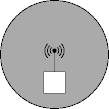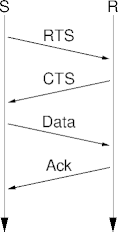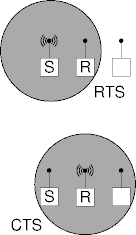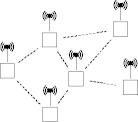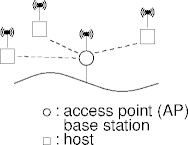Computer Networking Lecture Notes
1 November 2012 • Wireless Medium Access
Outline
- Wireless
- Propagation
- Reservation
- IEEE 802.11, Wi-Fi.
- Topologies and architecture
- Frames
Shared Channels
- Shared (multiaccess, broadcast, random access) channels.

Wireless Interconnects
Wireless Properties
- Three important wireless properties:
- Half duplex operation; a host can send or receive, not both.
- A time varying, complex channel.
- Frequent (1 in 103 BER) and bursty errors.
- A wired connection is full duplex, consistent and simple, and exhibits low, random errors.
- MAC protocols are correspondingly more complicated.
Propagation
- Assume radio signals propagate uniformly in all directions.
- Not even close to being true.
- Eventually signals become too weak to receive (fade).
- Distance squared drop-off.
|
|
|
Hidden Senders
- Both A and C want to send to B.
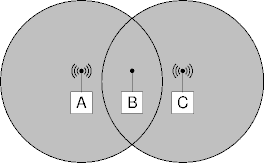
- The hidden sender problem.
Exposed Senders
- A wants to send to B, C wants to send to D.
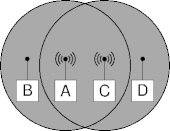
- The exposed sender problem.
- Also the discontinuous LAN problem.
Capture
- A are C sending to B, C’s signal is better than A’s signal.
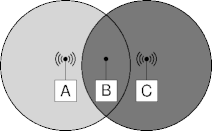
- C captures B.
Reservation
- Carrier sense is helpful but incomplete for wireless.
- Use small frames to reserve clear channels around sender and
receiver.
- Sender emits ready to send (RTS).
- Receiver emits clear to send (CTS).
- Data follows.
- This is known as multiple access collision avoidance (MACA, also CSMA/CA).
CSMA/CA
- RTS and CTS frames are small (10s bytes).
- Less likely to collide, less lost when they do.
- Sender’s and receiver’s neighbors hear the reservation frames and mute to avoid collisions.
- RTS and CTS contain expected channel hold time.
- Neighbors compute the mute-period size.
CSMA/CA Example
|
|
|
Wi-Fi
- Some of the IEEE 802.11 (Wi-Fi) standards.
802.11 GHz Mbit/sec* original 1997 2.4 2 a 1999 5 54 b 1999 2.4 11 g 2003 2.4 54 n 2009 2.4 or 5 600 - *Maximum; actual bit rates vary adaptively.
- Development continues.
802.11 Topologies
| Basic (ad hoc, mesh) | Extended | |
|
|
802.11 Architecture
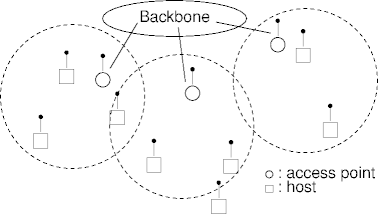
- Now imagine the hosts moving around.
Finding APs
- A host scans for an access point:
- Host broadcasts a Probe frame.
- APs reply with a Probe Response frame.
- Host chooses an AP and sends an Association Request frame.
- The AP replies with an Association Response frame.
- A host scans for an AP when it doesn’t have one, or it wants a better one.
Scanning
- Host initiated scanning is called active scanning.
- Access points also provide passive scanning.
- APs periodically broadcast Beacon frames.
- A Beacon frame advertises an AP and its capabilities.
- A hand-off occurs when a host changes APs.
802.11 Frames
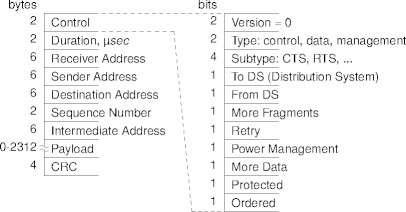
Summary
- Carrier sense is less of an advantage for wireless.
- And direct collision detection is impossible.
- IEEE 802.11 (Wi-Fi) is one of many wireless specifications.
- Others include Bluetooth, WiMax, and G3-G4-LTE.
- There are many 802.11 specs, and more are on the way.
| This page last modified on 2011 October 9. |
